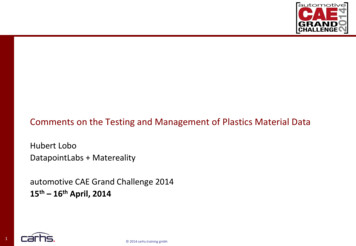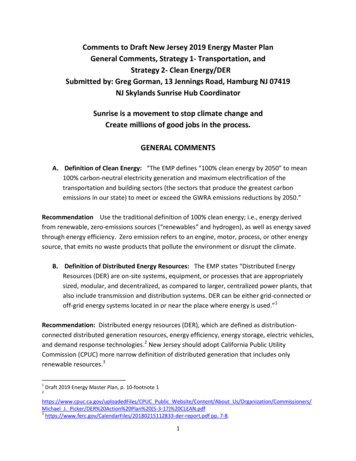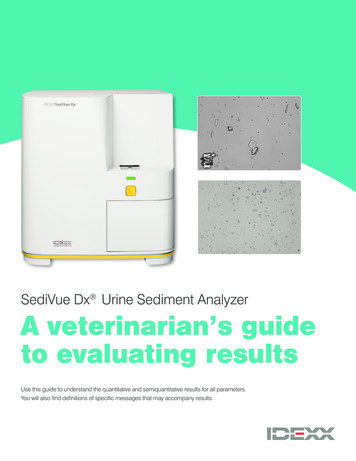
Transcription
Comments on the Testing and Management of Plastics Material DataHubert LoboDatapointLabs Materealityautomotive CAE Grand Challenge 201415th – 16th April, 20141 2014 carhs.training gmbh
Introduction to the companies technical center for materialsa DatapointLabs affiliateMaterialsTesting Data Infrastructure Productivity Software2 2014 carhs.training gmbh
Heritage1986 - Cornell Injection Molding Program (CIMP)Research: Properties of molten plastics for CAE1995 - Datapoint Testing ServicesCommercialization: Properties of plastics for molding CAE1998 - TestPaks Alliance ProgramPartnerships with FEA companies – properties & modeling for FEA2000 - Company rebranded as DatapointLabsSupporting 8 simulation codes for plastics2002 - Matereality startedR&D to create multivariate material database for plastics2014 - TodayTesting any materials any properties, supporting 34 CAE codesSuper-database software to analyze and transform material data3 2014 carhs.training gmbh
Challenge of testing and managing plastics dataData of multi-dimensional complexity Nonlinear Multivariate Anisotropic Effects of processingMaintain data self-consistency Slicing data without introducing artefact from multi-varying parametersData storage infrastructure must accommodate this complexity Ability to house multivariate data of any kind Graphical tools for multivariate analytics (comparison, statistics) Slicing and translation of data into CAE material cards4 2014 carhs.training gmbh
Range of plastics simulationPerformanceProcess Simulation Stiffness Failure Vibration Fatigue Creep and relaxation Impact5 Injection molding Blow molding Thermoforming Extrusion 2014 carhs.training gmbh
Key differences between plastics and metalsStress-strain relationship is linear until yieldProperties do not change over operating temperature rangeProperties do not change much with time Rate effects are modest Creep/stress relaxation is not a big issueGenerally isotropic or worst case, bi-directionalWell established material models mimic metal behavior6 2014 carhs.training gmbh
Complexity: nonlinearStress-strain is nonlinear Nonlinear elasticity Pre-yield plasticity Viscoelastic (time based effects) Volumetric straining at yield Localized neckingAluminumABS7 2014 carhs.training gmbh
Complexity: multivariateProperties change with Temperature- Low temperature embrittlement Rate- Ductile-brittle transitions Humidity / Heat aging- Embrittlement Environment – Fluid soak- Lowering in modulus / viscoelasticcharacteristics8 2014 carhs.training gmbhEffect of temperature
Complexity: processing effectsProperties affected by processInjection-molded plastics-Skin-core-skin sandwichWeld linesResidual stressesSpatial variation in x-y plane withfiber-filled plasticsBlow-mold/thermoform/extrusion9MD and CMD orientationStrong residual stressesThickness variationMulti-layer effectsPartial crystallization 2014 carhs.training gmbh
Procedure: handling the variationPart 1 – for the plastic material Identify the variables Test for the effect of variables (DOE?) Perform multivariate analytics to quantify effectsPart 2 – for the plastic component Identify the case under investigation Determine which variables to fix Obtain parameterized test data Convert to material model parameters10 2014 carhs.training gmbh
Case study: automotive bumper (TPO material)Identify variables Temperature (-40 to 80C) Strain rate (.01 to 100/s) Creep/stress relaxation Environment- Sunlight- Paint/coatings- Salt/humidity Fiber filler: none11 2014 carhs.training gmbh
Perform the material testingProcedure Develop test matrix Select parameters and variables Perform tests Dump data into Matereality12 2014 carhs.training gmbh
Using multivariate analyticsSelect multivariate data:-temperature dependent-rate dependentThen click Compare13 2014 carhs.training gmbh
Analytics: temperature effectsAll comparable data isautomatically cross-plottedTurn curves on and off toevaluate thermal effectsError band statistics aidsdecision making14 2014 carhs.training gmbh
Analytics: rate effectsTurn off temperatureeffects to view ratedependency15 2014 carhs.training gmbh
Use of CAE Modelers to send data to simulationCAE Modeler slices multivariate data into CAE-consumable slices rate dependency for LS-DYNA, PAMCRASH, ANSYS, ABAQUS temperature dependency for ABAQUS, ANSYS flow/thermal/PVT/shrinkage data for Moldflow, Moldex3D, Simpoe Converts material data to model parametersWrites files to Material Model Library16 2014 carhs.training gmbh
Adding complexity to the structural analysisAbaqus FeFp Nonlinear elasticity with pre-yield plasticityAbaqus PRF (evaluation project with Simulia) Viscoelasticity and nonlinear viscoelasticitySAMP-1 Post-yield non-Mises behaviorMATFEM MF GenYld CrachFEM (evaluation project with MATFEM) Post-yield non-Mises behavior and failureDIGIMAT Spatial variation of properties due to fiber-orientation Rate dependency, creep, viscoelasticity, fatigue and failure17 2014 carhs.training gmbh
SAMP-1 case study: polycarbonate for headlight lensFeaturesIsotropic material modelTensile rate dependencyDeviatoric and volumetric plasticityNon-Mises yield locusApplicationPost-yield plasticityNot specified for failure predictionTesting RequirementsRate dependent tensile dataYield locusPlastic Poisson’s ratio18 2014 carhs.training gmbh
SAMP-1 Poisson’s ratio v. strain0.60.5TotalPlasticPoisson's Ratio Quantifies the volumetricchange that accompaniesplasticity Large volumetric change at yield0.40.30.20.10.00204060Engineering Strain (%)19 2014 carhs.training gmbh80100
SAMP-1 shear propertiesIosipescu methodsDICShear stress-strain for PC20 2014 carhs.training gmbh
SAMP-1 Compressive and biaxial testsyzxlubricationsheet21 2014 carhs.training gmbh
SAMP-1 yield locus for polycarbonate1.5May not follow von Mises criterion10.50- 1.5-1- 0.50- 0.5-1- 1.522 2014 carhs.training gmbh0.511.5
Bringing in process simulationMelt state properties (injection molding) Non-Newtonian temperature dependent viscosity Thermal properties Pressure-volume-temperature (PVT)Solid state properties Mechanical & thermal properties for shrinkage/warpageViscoelastic properties (blow-molding/thermoforming/extrusion) Frequency or time based response in melt state Rate dependent biaxial properties in melt23 2014 carhs.training gmbh
Testing for molding simulation: rheology3-4 temperaturesEffect of shear rateData corrections24 2014 carhs.training gmbh
Testing for molding simulation: specific heatCoolingMark the transitions25 2014 carhs.training gmbh
Testing for molding simulation: thermal conductivityCoolingMark the transitions26 2014 carhs.training gmbh
Testing for molding simulation: PVTMany schemes possible Isothermal heating Isobaric coolingMark transitions27 2014 carhs.training gmbh
Testing for molding simulation: shrink/warpMany schemes possible Orthotropic Moldflow, Moldex3D, SIMPOE Orthotropy with viscoelastic Sigmasoft CRIMS Moldflow28 2014 carhs.training gmbh
Coupling mold analysis with FEA: DIGIMATDIGIMAT- for process-induced spatial variation of propertiesCase Study: Automotive Instrument Panel (PP/GF)Process Obtains orientations input from process simulation Applies a DIGIMAT material model to scale properties based on orientation Transfers model with spatially varying properties to FEAAvailable material models Stiffness Failure Crash simulation Creep and viscoelasticity Fatigue29 2014 carhs.training gmbh
Testing for DIGIMATMold 100X200X3.16mm plaques Edge gated on 100 mm end Long flow length Fully developed flow High fiber orientationCut test specimens by CNC5 specimens each (0 , 45 , 90 )Obtain true stress-strain dataTest for other characteristics creep, fatigue, viscoelasticity30 2014 carhs.training gmbh
ConclusionsPlastics are challenging materialsPlastics bring important business advantages over conventional materialsPlastics carry considerable risk if improperly usedUnderstanding the behavior of your plastics is vitalKnowing how the plastics will perform in your products is criticalMaterial testing is key to developing this understandingMaterial data is often not generic but specific to the products (Dr. Kolk, BMW 2013)Valuable and expensive test data must be carefully kept and consistently usedThank You!31 2014 carhs.training gmbh
16 2014 carhs.training gmbh Use of CAE Modelers to send data to simulation CAE Modeler slices multivariate data into CAE-consumable slices











